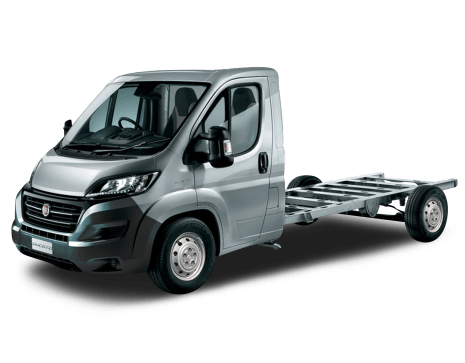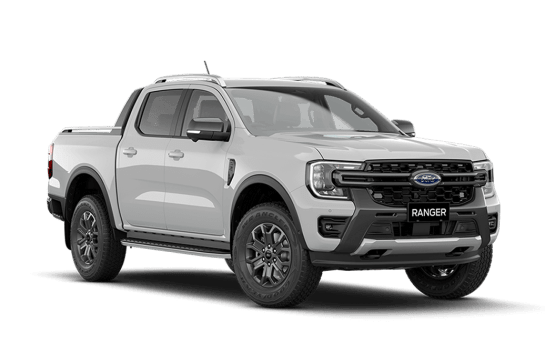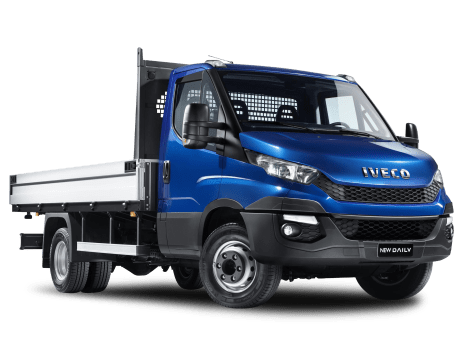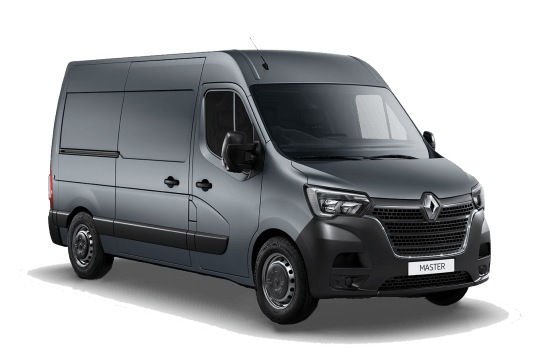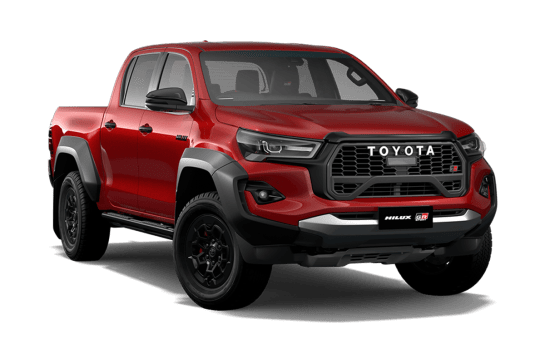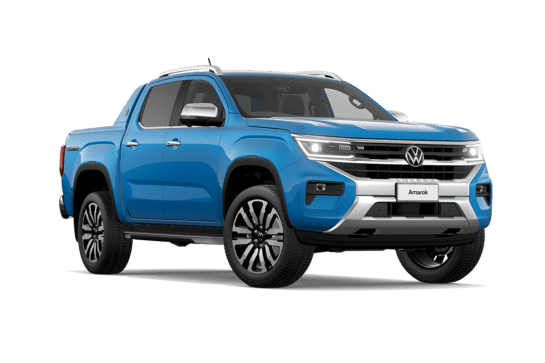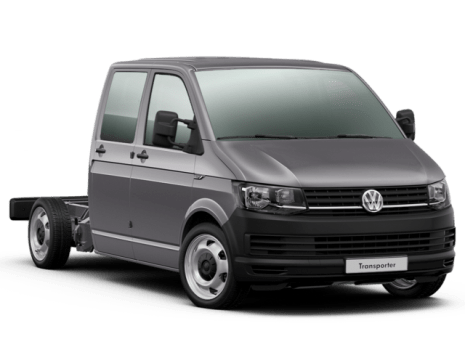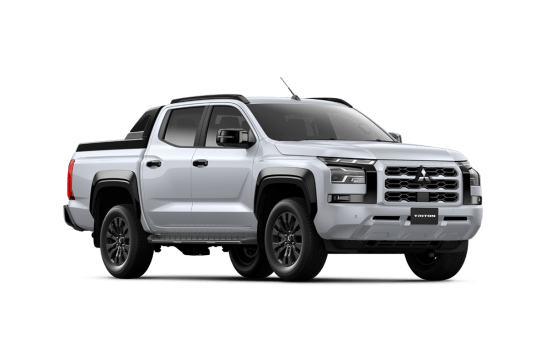
Mitsubishi Triton VS Volkswagen Crafter
Mitsubishi Triton
Likes
- New looks
- Smooth steering
- Super Select 4WD-II
Dislikes
- Tyres
- Tub liner should be standard
- Driver attention alert is overactive
Volkswagen Crafter
Likes
- Less confronting to drive than a caravan combo
- All-Terrain model has real adventure appeal
- Carries full VW factory warranty
Dislikes
- Good value, but still a lot of money
- Won't cut it as a daily car outside holidays
- Needs plenty of real estate for parking or storage
Summary
Mitsubishi Triton
The new-generation Mitsubishi Triton range was launched last year, marking the biggest change for the vehicle in a long time: a new bi-turbo engine (150kW/470Nm), overhauled design, new chassis and suspension (pushing towing capacity to 3500kg), and longer wheelbase, among a raft of changes.
Now, here’s the GLX-R, a new mid-spec variant in the Triton line-up. The GLX-R badge did exist in previous Triton generations, but the new version gets a few things, such as black alloy wheels, tailgate assist, and a leather-wrapped steering wheel, over and above current-generation lower-spec vehicles.
But much more importantly, it also gets Super Select 4WD II, which is only available in higher spec Triton variants.
Read more about
- Current Mitsubishi ASX is no more. Cut-price popular SUV's replacement confirmed: 2025 Mitsubishi ASX small SUV with potential hybrid power to ready for battle with the Hyundai Kona, Toyota Corolla Cross and MG ZS
- 'We plan to be here for another 40 years': How Mitsubishi plans to be a big player in the face of new competition such as BYD Sealion 6 and Shark 6 and without the Pajero Sport and Eclipse Cross and likely pricier ASX SUVs
- Watch your back Ranger Raptor, legendary badge could return to Australia: Mitsubishi to bring back the Ralliart with a potential Triton, Pajero Sport or Pajero hardcore 4WD
So, is the Triton worth your attention?
Read on.
| Safety rating | |
|---|---|
| Engine Type | 2.4L turbo |
| Fuel Type | Diesel |
| Fuel Efficiency | 7.7L/100km |
| Seating | 5 seats |
Volkswagen Crafter
Long before a hash-tag was anything more than a confusing symbol on a typewriter, vanlife was already a thing.
And you can largely thank Volkswagen for that because its Kombi models from the 1950s, '60s and '70s help cement the idea of roaming around the planet in a self-contained car-cum-house as a counter-culture favourite. More than that, the affordable, rugged Kombi made it actually possible.
Back then, there were a couple of paths to tread. You could take a second-hand butcher’s or florist’s Kombi van (windows optional) and trick it out with a bed, a table and whatever gear you needed to survive on the road.
Read more about Volkswagen
- This is the Volkswagen Amarok SUV, a sibling to the Ford Everest 4WD that's yet to become a production model
- 2025 Volkswagen Crafter van gains ChatGPT as part of model year update for Ford Transit, Renault Master rival
- Hi-po electric Kombi! 2025 Volkswagen ID. Buzz GTX revealed ahead of Australian arrival where it will take on the Mercedes-Benz EQV and LDV Mifa9
Or, if the cash was around in sufficient quantities, you could buy a Kombi brand-new and have it converted to camper spec. And of all those brand-new conversion options, Volkswagen’s own, in-house conversion supplier, Westfalia was (and is) regarded as the pick of the crop.
So, when VW announces a 21st Century take on the concept of a factory campervan, those who like the idea of a lap of Australia but don’t like caravans or towing, are suddenly all ears.
Like most things, the latter-day VW camper has grown a size or two over the last six or seven decades. Which is why the factory Kampervan TD1410 4 Motion (to give it its full name) is based on the long-wheelbase, high-roof version of the Crafter van rather than the original Transporter layout. (There’s still the VW Multivan-based California if the Kampervan is too big.)
But just as commercial vehicles have become bigger and more sophisticated, and glamping has grown out of actual camping, does the modern take on a hippy legend make the grade in 2024? And does the Volkswagen offering retain any of the charm of the original campervan?
Oh, and forget about Westfalia. This conversion is the work of none other than Aussie caravan specialist Jayco.
The deal between Jayco and VW locally, means this variant of the Crafter Kampervan is an Australia-only deal.
| Safety rating | — |
|---|---|
| Engine Type | — |
| Fuel Type | — |
| Fuel Efficiency | —L/100km |
| Seating | — |
Verdict
Mitsubishi Triton7.4/10
The previous-generation Mitsubishi Triton makes a pretty good case as a solid all-rounder and a decent value-for-money purchase – but the new-generation Triton package is simply much better.
You can really see the value in the latest round of massive changes the line-up has undergone and those changes have brought the Triton closer to the top of the pack – it’s not quite there yet – but it’s very close.
The Triton is now the best iteration of this vehicle – refined, well equipped and nice to drive – and on the same level as the Isuzu D-Max, and drawing even closer to the likes of the Ford Ranger.
In GLX-R spec, the Triton strikes a nice balance between workhorse and weekend adventure machine.
Volkswagen Crafter8.1/10
This is not the vehicle for somebody looking for the odd weekend away. That’s mainly because it will take up a lot of real estate when you’re not using it (it may not even fit in a lot of car-ports or garages) and it’s far from a daily driver for the school run or shopping trips.
If you’re looking for a getaway machine that will also work at home for the other 48 weeks of the year, a conventional caravan and four-wheel-drive is likely to be a better bet, purely because the tow-vehicle can be your day-to-day transport
But if your plans include longer getaways and you have the storage space to keep the Kampervan stashed away safely, it starts to emerge as a functional alternative.
Talk to long-term travellers, and even the best camper trailer needs to be set up each night and folded away next morning, and as for tents, don’t even start us…
But like a full-sized caravan, the VW simply pulls up to where ever it is you want to stay for the night and is ready to feed, entertain and rest its occupants within seconds of stopping.
But unlike a big, heavy caravan, the Volkswagen imposes far fewer driving caveats (including fuel consumption) and is a vastly more enjoyable and simple thing to drive in pretty much any circumstance.
It's not for everybody, but for those whose lifestyle it matches, the VW Kampervan is an alternative to a caravan that deserves short-listing. Let’s face it, 50 million hippies can’t be wrong.
Note: CarsGuide attended this event as a guest of the manufacturer, with accommodation and meals provided.
Design
Mitsubishi Triton
The new Triton is 5320mm long (with a 3130mm wheelbase), 1865mm wide, 1815mm high, and it has a kerb weight of 2120kg.
This new-generation Triton looks far more imposing than previous Tritons with its stretched wheelbase, bulky front end with prominent grille, big wing mirrors and a taller stance overall.
The GLX-R also benefits from the illusion of more height off the deck because the side steps have been removed. Take it from me, a vertically challenged bloke, it’s a climb to get into the cabin.
Highway terrain tyres (Maxxis 790 Bravo (265/60R18 110H) are used on the GLX-R, rather than all terrain tyres. Higher-spec GLS and GSR Tritons also ride on highway terrain tyres, with the lower-spec GLX and GLX+ ride on all terrain tyres (265/65R17 112H).
This variant also gets a Mitsubishi-branded sports bar, which is pretty cool if you're into that sort of thing.
The Triton’s interior remains similar to other variants in that it has a basic but tidy layout and plenty of durable plastic surfaces. The GLX-R has cloth seats with silver stitching, and carpet flooring (with rubber floor mats in the test vehicle).
Volkswagen Crafter
Given that the design of the camper conversion was partly the work of Jayco, there’s every reason to suspect that the end result should work for recreational users. That is, of course, provided Jayco’s caravan-building experience translates to a campervan layout.
That’s because this is not as simple as plonking a wheel-less caravan onto a Crafter cab-chassis; integration in the key here.
The various zones – driving, entertaining, sleeping, bathroom and cooking – need to work with each other with as many components having more than one job.
The off-grid capability is also a highlight and, in the case of the All-Terrain model with its off-road tyres, bash plates and 30mm higher ground clearance, makes getting farther off the beaten track more of a reality.
A lot of people will wonder why VW didn’t simply import a batch of the campervan conversions it already builds in Europe.
The fact is, however, that the left-hand drive layout means the sliding side door would be on the wrong side for Australia, and the integrated gas system would not have met ADR standards. So was born the idea of a local conversions which is where Jayco came in.
Practicality
Mitsubishi Triton
The GLX-R’s cabin is well suited to work and play. As mentioned, there’s hard plastic surfaces everywhere, cloth seats, rubber mats, and carpet flooring. It's all designed to be able to cope with the wear and tear of everyday life.
All controls are easy enough to operate, easy to find, there aren’t any real annoyances here.
There's plenty of storage everywhere, including a handy deep open space above the glove box, and charge points up front, too (a USB-A and a USB-C).
The back seats are comfortable and supportive, with plenty of bolstering there.
Overall, the cabin is a bit on the Spartan side – there’s no frippery here, which is fine with me.
The Triton’s tub is 1555mm long, 1545mm wide, 1135mm wide between the wheel arches, and 525mm deep. Load height is 820mm.
The GLX-R tub has a hard plastic liner – but that’s an extra-cost accessory – and that seems adequately sturdy. The tub has four tie-down points at each corner of the cargo load space.
Our test vehicle has a soft tonneau cover, but that is also not standard on the GLX-R.
Otherwise, the rear cargo area is a usable space, and the GLX-R does benefit from the fact it has tailgate assist.
The Triton has an underlying full-size alloy spare beneath the tub.
Volkswagen Crafter
The Crafter’s phone mirroring system seems to work pretty well, although it’s menu-driven layout can be a bit frustrating (it’s hardly alone there) and Android phones sometimes didn’t want to connect as simply as they should have (potential user-error here, folks).
But the rest of the interior is typically Crafter-smart including lots and lots of cupholders, USB ports and cubby-holes dotted around the front seat area.
Doubtless, a few months on the road will show up design issues according to the individual, but for now, our main comment would be the proximity of the bathroom to the food preparation area (although, to be fair, most owners will cook outside the vehicle).
The mattress is a split queen unit (rather than a single mattress) and it occupies the full width of the rearmost part of the vehicle, so making the bed might be a bit more difficult.
The location and width of the bathroom (although it feels pretty tiny once you’re in there and operates as a wet-room) also means there’s just half the rear view that the vehicle might otherwise have.
The thick pillar between the two rear barn-doors also adds to that blind spot. At least the mirrors are good; nice and wide and very clear.
It’s when the Kampervan is not being used to survey this wide, brown land that its practicality starts to come into question. Unlike a conventional four-wheel drive and caravan rig, the accommodation section of the Crafter can’t simply be unhooked and parked in the driveway.
Which means it’s not really suburb or city-friendly. Underground car-parks will soon detach the air-conditioning unit in a pretty violent way, and the almost-seven-metre length will have you looking for adjacent empty parking spaces (or the car-and-trailer section at Bunnings).
Put simply, this is the touring solution for those who want to tackle the Big Trip in one go, staying on the road for weeks or perhaps even months. Obviously, that’s an observation rather than a criticism, but it remains something to think about.
Price and features
Mitsubishi Triton
The Mitsubishi Triton GLX-R is a five-seat dual-cab ute and it has a base price-tag of $56,740 (excluding on-road costs).
Our test vehicle is equipped with electric brake controller with harness ($850), rubber mats with low edge ($125), an under rail tub liner ($750), a tow bar kit ($1450), a soft tonneau cover ($900) and a 50mm chrome towball ($42), all adding up to a total of $60,857 (excluding on-road costs).
As standard, this Triton’s features list generously includes an 9.0-inch multimedia touchscreen system (with wireless Apple CarPlay and Android Auto), a 7.0-inch multi-function display, manually adjustable front seats with heating, fabric upholstery, a 360-degree camera system, dual-zone climate control and a refrigerated centre console and more.
It also gets a leather-wrapped steering wheel, black 18-inch alloy wheels, Super Select 4WD II and a rear differential lock.
The GLX-R’s black sports bar and tailgate assist – both genuine accessories – are fitted at the factory.
Exterior paint choices include white or red (both at no extra cost), or Impulse Blue, Blade Silver, Graphite Grey or Black Mica will each set you back $740.
Volkswagen Crafter
Based on the top-shelf Crafter van, the Kampervan then goes on a mission to be both a car and a holiday house.
So, pull up a comfy chair, because there’s a fair bit to discuss here. This isn’t just a tent on wheels, it’s a fully functional tiny home that just happens to be relocatable on a daily basis. As such, the vehicle needs to be able to manage energy, water, gas and waste.
VW’s aim was to elevate the quality standards of the caravan industry to that of the car-making world, as well as address its customers’ main agendas, including storage, the ability to go off-grid and the management of light and ventilation for sleeping.
That utility starts with the walk-through layout where the front seats swivel to form the other half of the dining table seating. From there, the layout runs to a full bathroom, a kitchen and then back again to a fixed queen-size bed.
The bathroom combines a shower and a lavatory with a cassette system for black-water storage and disposal.
The kitchen features a 90-litre fridge with a freezer drawer that is accessible form both inside and outside the vehicle. There’s a dual gas-hob and a 9.0kg gas bottle stored in the rear compartment (under the bed, but accessed from outside) that also includes a huge slide-out drawer for an extra fridge or whatever else needs to be carted around.
There’s also a sink with a mixer tap and the vehicle carries 120 litres of fresh water, not to mention gas-powered on-demand hot water.
A wind-out awning runs the full length of the van, extending the living space and forming a space for the VW-branded camping table and chairs.
The bedroom includes a pair of swivelling fans for cross-ventilation, USB and 240-volt ports, a swivelling TV and blinds and screens on all windows. The standard air-conditioning system will also run for about seven hours before the vehicle runs out of power.
Speaking of power, the electrical system is a force of nature. Aside from the standard Crafter battery (which remains the start battery and can’t be depleted by the equipment on board) the standard smart-alternator function has been disabled so the engine can help charge the batteries whenever possible.
That power storage array incorporates a 400Ah lithium-ion battery with a 3000-watt inverter to run the 240-volt system even when off-grid. There’s a 60A DC-to-DC charging system and, all up, VW reckons the vehicle can stay off grid for about three days straight based on normal power consumption. A multi-screen control panel tracks power usage and issues alerts when required.
So, what’s missing from the Kampervan? Climate-control air-conditioning for the cabin, mainly (the Crafter starts life as a commercial van, after all). Oh, and beds for the third and fourth passenger. Cue hippy-free-love jokes.
The Kampervan starts at $157,990 for the on-road biased Style model and $165,490 for the All-Terrain version.
As the more off-road capable variant, the All-Terrain gets 16-inch steel wheels with all-terrain tyres, bash plates, a higher ride height and a snorkel.
In either case, the accommodation fittings and fixtures are identical, that sounds pretty steep, but go out and price a full-sized four-wheel drive and a full-sized caravan with a bathroom and then see how it all stacks up.
Under the bonnet
Mitsubishi Triton
The Mitsubishi Triton GLX-R has 2.4-litre four-cylinder bi-turbo diesel engine, producing 150kW at 3500rpm and 470Nm at 1500-2750rpm.
It has a six-speed automatic transmission and a full-time dual-range four-wheel drive system, Super Select 4WD-II.
This is an impressive combination – not particularly exciting or dynamic, but it’s smooth, and offers a decent amount of torque across a wide rev range for 4WDing.
It has selectable drive modes which include Normal, Eco, Gravel, Snow, Mud, Sand, and Rock.
Volkswagen Crafter
The Crafter is powered by VW’s now-familiar 2.0-litre turbo-diesel four-cylinder engine which produces 130kW of power and 410Nm of torque thanks to a pair of turbochargers.
Driving through an eight-speed automatic transmission, the torque is then sent to all four wheels via VW’s '4Motion' permanent all-wheel-drive system.
It’s worth mentioning the automatic transmission is a conventional torque-converter unit, rather that the dual-clutch layout VW has championed for years now.
The Crafter also uses ventilated disc brakes front and rear and the however you look at it, the modern driveline of the Kampervan makes an old air-cooled Kombi look even more antiquated (which is saying something).
And while the Crafter in commercial-vehicle trim has the option of an electronic locking rear differential, the Kampervan adds this as standard.
Efficiency
Mitsubishi Triton
The Mitsubishi Triton GLX-R has an official fuel consumption of 7.7L/100km (on a combined cycle).
I recorded 9.2L/100km on this test. I did a lot of high- and low-range 4WDing and the Triton was never working hard.
The Triton has a 75L fuel tank so, going by my on-test fuel-consumption figure, you could reasonably expect a driving range of about 815km from a full tank.
It also has a 17.0-litre AdBlue tank.
Volkswagen Crafter
Although the Crafter’s driveline boasts energy recuperation, it’s not a hybrid system. Instead, the vehicle’s alternator is able to generate electricity during braking and store that in the vehicle’s batteries for later use, rather than storing that power in a dedicated hybrid battery.
This also helps ensure the main battery is always fully charged to power the stop-start system that is also standard on the Crafter.
Because it’s a commercial vehicle, there’s no compulsion to offer an official fuel consumption figure and, indeed, Volkswagen doesn’t.
But our real world drive including some winding roads and a bit of freeway thrown in, gave us an average figure of between nine and 10 litres per 100km. This is likely to be a bit lower on a purely highway run, but is a good indicator of general use consumption.
The 75 litre fuel tank should, then, give an easy 700km of range, but don’t forget the Crafter’s engine uses AdBlue, so that extra cost needs to be factored into running costs.
Driving
Mitsubishi Triton
On sealed surfaces, the Triton is punchy off the mark if you pressure it, and it’s surprisingly smooth and refined at highway speeds, simply trucking along.
A new chassis frame, redesigned suspension, longer wheelbase, and wider wheel track, all contribute to the Triton exhibiting more controlled and comfortable ride and handling than ever before.
With its new suspension design – high-mounted double wishbone with coil spring and stabiliser bar up front and leaf springs at the rear – the Triton feels more settled and composed, more sure-footed on bitumen roads and gravel tracks, in terms of ride and handling.
The power-assisted steering offers a light but precise feel, the engine has a quiet refinement about it, and the six-speed auto is clever enough to not warrant any legitimate criticism.
So, getting to and from your favourite 4WDing track or campsite is a whole lot more comfortable now than in previous Tritons. But how does this new bigger Triton go when it comes to low-range 4WDing?
Well, it's actually quite impressive.
The previous-generation Triton had a shorter bonnet, so driver visibility when you are 4WDing is a whole lot better because the new-generation Triton has quite a substantial bonnet, so your vision forward of the vehicle is somewhat impaired, but that is rectified, to a certain degree by a 360-degree camera, and that will operate while you are low-range 4WD or driving at low speeds.
That camera gives you a view to the side and rear of the vehicle and, more importantly, to the front of the vehicle so you can maintain your correct line on the track.
The Triton has strong and sharp throttle response, which is very handy while 4WDing when you need to instantaneously tap into that torque.
The GLX-R benefits from having Super Select 4WD-II onboard, which lower-spec variants do not get it.
I’ve sung the praises of this system many times before and it constitutes a major and crucial point of difference that Tritons or Pajero Sports (equipped with this system) have with their rivals.
Super Select 4WD-II adds an extra element of safety and sure-footedness to driving. Via a dial to the rear of the auto shifter, you can switch from 2H into 4H (four-wheel drive, high-range) to give you the best traction possible in traction-compromised situations (i.e. rain-soaked blacktop, rough back-roads or dirt tracks peppered with loose rocks and potholes).
There's no risk of transmission wind-up when 4H is engaged in the GSR because the centre diff remains open.
Then turn the dial to 4HLc (four-wheel drive, high-range, locked centre diff) and you're ready to take on more difficult terrain but at lower speeds, because now the centre diff is no longer open.
If you want to tackle even more difficult terrain than high-range 4WD territory, turn the dial to 4LLc (four-wheel drive, low-range, locked centre diff) and the Triton has the opportunity to excel in low-speed, low-range four-wheel driving.
This Triton also has a rear diff lock, which is engaged/disengaged via a button in front of the shifter and this further helps you to comfortably maintain safe forward momentum.
The GLX-R also has selectable off-road modes, including Gravel, Sand, Mud/Snow (when in high-range 4WD) and Rock (when in low-range 4WD). Each of these modes adjusts engine output, transmission settings and braking, the aim being optimal traction to suit specific conditions and terrains.
This new-gen Triton is a bigger vehicle with a longer wheelbase and a turning circle of 12.4m, so it doesn’t feel as nimble on bush tracks as the previous Triton.
And because of its size, you do have to drive this new-generation Triton with more focus than you might've gotten away with in the old Triton simply because it now takes up more space on the track than it ever has before.
The Triton’s ground clearance (a listed 228mm) and off-road angles – 30.4 degrees approach, 22.8 degrees departure and 23.4 degrees rampover – all check out and are standard for a ute of this kind, however, the Triton does feel low and vulnerable to scraping that underbody on rocks, sticks, tree roots, etc.
It does have what Mitsubishi describes as “heavy duty” underbody protection (there’s a plastic bash plate towards the front of the vehicle and a steel bash plate behind that). That underbody protection does seem quite substantial, but I wouldn't rely on those to cop severe punishment.
The rear diff housing also seems prone to copping a solid knock or two, especially if you're tackling some hard-core rock-climbing, steep hills or severely rutted downhill crawls.
The GLX-R does not have side steps, which makes it look and feel a bit taller off the deck, but that does mean that if the vehicle tips to the side at a severe angle – for example, while driving through a deep high-sided rut – the bottom edge of a door or the bottom of the chassis may take the full brunt of the hit, rather than a sidestep copping the worst of the knock.
Another niggle – and it's a trait of most contemporary 4WDs straight out of the showroom – is the fact that the GLX-R gets a set of tyres – Maxxis 790 Bravo (265/60R18) – that are better suited to the highway than they are to any even mild 4WD terrain. However, it’s easily remedied: just swap in a set of decent all-terrain tyres – go as gnarly as you want – and that will make this capable 4WD even more capable.
Otherwise, all the good stuff is here: the mechanicals (Super Select 4WD-II etc.), the off-road traction control system is well calibrated, and the rear diff lock is easily engaged and disengaged at the press of a button.
Towing capacity is 750kg (unbraked) and, worth noting, is the Triton’s braked towing capacity has increased to 3500kg (up from 3100kg), bringing it up to par with its dual-cab rivals.
Kerb weight is 2120kg, maximum payload is 1080kg, GVM is 3200kg, and GCM is 6250kg.
Volkswagen Crafter
You can see the appeal of a high driving position the moment you step into (or climb into, really) the Kampervan. The view out is fabulous and even though the vehicle is just shy of seven metres long, you soon develop a bit of a sixth sense for where the back wheels are, based on what the front wheels have just done.
The glass area is huge with the exception of the view to the rear thanks to that bathroom placement.
The front seats are big and comfy, although the two rear seats are pretty flat and place the occupants quite close together. There’s enough adjustability in the seat and steering column to make anybody feel at home and the exterior mirrors are big and clear.
There’s enough performance, to be sure, but the sheer mass of the Kampervan and the fact that it’s moving a lot of air means you’ll be giving the rather long-travel accelerator a decent workout.
Taking off into traffic is the only time the VW will feel a bit sluggish, but once the engine has a few revs on board it all gets going fairly smartly.
Unlike a lot of modern cars that can feel as though they're travelling a lot slower than they really are, the Kampervan is the opposite. Not that it’s spooky to drive, but there will be times you’ll be in a 100km/h zone, look down and discover you’re doing 90.
In the context of a leisure vehicle, this shouldn’t bother anybody apart from a highway patrol officer down on his or her monthly quota.
The engine is smooth and the transmission is refined and possesses enough smarts to make a better job of shifting itself than the driver ever will.
It’s not exactly silent inside, though, with a smattering of clicks and clatters from some of the less-automotive furniture, but it’s a fair bet even a brand-new house would likewise rattle a bit if you hurled it down a bumpy road at 100km/h.
The biggest source of noise pollution, though, is in the All-Terrain model and consists of a chorus of sucking, sobbing, choking and burping noises from the snorkel which is placed right near the driver’s right ear. Obviously, it’s worse with the window open.
Ride quality is very good. Clearly, having a bit of weight on board doesn’t hurt, but even so, the Kampervan refuses to pitch or wallow despite that ride compliance. In fact, it’s very composed for such a big unit that was originally designed to carry parcels and pallets.
Safety
Mitsubishi Triton
The Triton GLX-R has the maximum five-star ANCAP safety rating from local testing in 2024.
As standard it has eight airbags (driver and front passenger airbags, driver knee airbag, centre airbag, driver and front passenger side airbags, and curtain airbags) and driver-assist tech includes AEB, adaptive cruise control, blind-spot monitoring, lane-keeping assist, driver attention alert (it's annoying), front and rear parking sensors, a 360-degree camera and more.
Volkswagen Crafter
The Crafter, on which the Kampervan is based, is typical of the emerging breed of commercial vehicles that try not to give anything away to passenger cars in safety terms.
Well, in the front seats anyway, because the two seats in the rear are formed by a bench seat that doubles as a kitchen-table seat, so lacks the contouring of most car seats.
More importantly, the rear seats miss out on side-curtain airbags. This is understandable given the vehicle’s origins. Both rear seats do, however, feature top-tethers for child restraints.
Up front, meantime, the two front passengers get both front and side-curtain airbags with a full array of driver aids to help with safety.
They start with stability control, anti-lock brakes, brake-assist, traction-control, multi-collision braking and hill-holding function.
There’s also autonomous emergency braking that works at speeds up to 60km/h, driver-fatigue detection, a rear view camera, adaptive cruise-control, rear cross-traffic alert, blind-spot monitoring and lane-keeping assistance.
What’s missing? Apart from the side airbags for all passengers, we’d like to see tyre-pressure monitoring on such a large, heavy vehicle and AEB that works beyond 60km/h.
The Kampervan has not been ANCAP tested.
Ownership
Mitsubishi Triton
The Triton is covered by Mitsubishi’s near market-leading 10 year/200,00km warranty, as long as you have it serviced at an authorised Mitsubishi dealership. If not, you get half the coverage.
Servicing is scheduled for every twelve months or 15,000km and, under Mitsubishi’s capped-price servicing, each of the first 10 services costs $390.
Volkswagen Crafter
The Kampervan carries Volkswagen Australia’s full five-year/unlimited-kilometre warranty. That extends to not just the base vehicle, but the whole conversion including all of Jayco’s additions and other aftermarket fittings.
VW offers a version of capped price servicing called its 'Service Care Plan' that covers scheduled maintenance for the first five years and can be purchased at the time the vehicle is ordered.
No price for this was available as we went to press, but for reference, the same five-year service plan for the Amarok dual-cab ute costs $1900.
Standard service intervals are every 12 months or 20,000km, whichever comes first.

